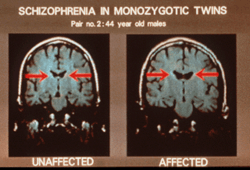Ventricular-brain ratio

Ventricular-brain ratio (VBR), also known as the ventricle-to-brain ratio or ventricle-brain ratio, is the ratio of total ventricle area to total brain area,[1] which can be calculated with planimetry from brain imagining techniques such as CT scans. It is a common measure of ventricular dilation or cerebral atrophy in patients with traumatic brain injury or hydrocephalus ex vacuo.[2] VBR also tends to increase with age.[1]
Generally, a higher VBR means a worse prognosis for recovering from a brain injury.[2] For example, VBR is significantly correlated with performance on the Luria-Nebraska neuropsychological battery.[3] Studies have found people with schizophrenia have larger third ventricles and VBR.[4] Correlational studies have found relationships between ventricle-brain ratio and binge eating and inversely with plasma thyroid hormone concentration.[5]
See also
References
- ↑ 1.0 1.1 Theodore Eliot Keats; Christopher Sistrom (2001). Atlas of Radiologic Measurement. Elsevier Health Sciences. pp. 42–. ISBN 0-323-00161-0.
- ↑ 2.0 2.1 Nathan Zasler; Douglas Katz, MD; Ross D. Zafonte (2007). Brain Injury Medicine: Principles and Practice. Demos Medical Publishing. pp. 207–. ISBN 978-1-888799-93-4.
- ↑ R. N. Malatesha; Lawrence C. Hartlage (1982). Neuropsychology and Cognition: Proceedings of the NATO Advanced Study Institute on Neuropsychology and Cognition, Augusta, Georgia, U.S.A., September 8-18, 1980. Springer. p. 86. ISBN 978-90-247-2728-5.
- ↑ Lee N. Robins; Michael Rutter (1990). Straight and Devious Pathways from Childhood to Adulthood. CUP Archive. pp. 333–. ISBN 978-0-521-42739-5.
- ↑ C. Edward Coffey; Roger A. Brumback (2006). Pediatric Neuropsychiatry. Lippincott Williams & Wilkins. pp. 314–. ISBN 978-0-7817-5191-9.